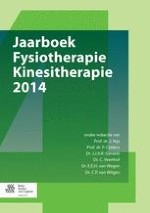2014 | OriginalPaper | Hoofdstuk
11. Bekkenfysiotherapie bij volwassenen met fecale incontinentie
Auteurs : Bary Berghmans, Esther Bols, Erik Hendriks, Cor Baeten, Rob de Bie
Gepubliceerd in: Jaarboek Fysiotherapie Kinesitherapie 2014
Uitgeverij: Bohn Stafleu van Loghum
